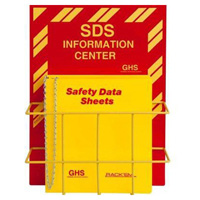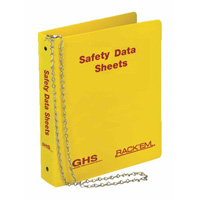| The Home page of ILPI's Safety Data Sheet (SDS) Resource, the leader in SDS information since 1995! | |
| The history and philosophy behind this resource. | |
| A curated collection of books and reference materials concerning Safety Data Sheets and closely related topics. | |
| Paste your plain text SDS into the SDS-Demystifier, and it will be converted into a hypertext-enriched document with links to detailed explanations of each key term. | |
| An extensive list of frequently asked questions about Safety Data Sheets including regulations, content, compliance, and more. | |
| A humorous take on Safety Data Sheet jargon. Fill in the blanks on our entry form to generate a personalized Unsafety Data Sheet to share with your coworkers. | |
| Since 1995, we've maintained this massive curated list of the best places to find Safety Data Sheets on the Internet. | |
| Way more than a glossary, this hypertext-enhanced resource covers hundreds of SDS-related terms and expert knowledge. Each entry includes both the SDS relevance and links to additional authoritative resources. | |
| Archived results of Safety Data Sheet related polls taken by some of our millions of site visitors | |
| You are here! The OSHA regulations behind SDS regulations, including the inspection guidelines and over 400 official interpretations letters under the Hazard Communication Standard | |
| Commercial suppliers of SDS authoring and management software as well as cloud compliance services. | |
| Commercial companies that will create SDS's for your specific needs as well as SDS translation companies. |

Safety signs, banners, and scoreboards? Get yours at Safety Emporium!
CPL 02-02-079, Appendix A
Table of Contents for Appendices A and B of the Hazard Communication Standard
This list is provided for easy reference to the chapters of Appendices A and B of the Hazard Communication standard (HCS). This Appendix provides CSHOs [Compliance Safety and Health Officers] with an easy way to quickly find the appropriate chapters when reviewing the classification of chemicals. Please review each chapter of the Appendices to the HCS as needed.
Appendix A: Health Hazard Criteria
-
A.0 General Classification Considerations
A.0.1 Classification
A.0.2 Available data, test methods and test data quality
A.0.3 Classification based on weight of evidence
A.0.4 Considerations for the classification of mixtures
A.0.5 Bridging principles for the classification of mixtures where test data are not available for the complete mixture
-
A.0.5.1.1 Dilution
A.0.5.1.2 Batching
A.0.5.1.3 Concentration of mixtures
A.0.5.1.4 Interpolation within one toxicity category A.0.5.1.5 Substantially similar mixtures
A.0.5.1.6 Aerosols
-
Table A.1.1: Acute toxicity hazard categories and acute toxicity estimate (ATE) values defining the respective categories
Figure A.1.1: Tiered approach to classification of mixtures for acute toxicity
Table A.1.2: Conversion from experimentally obtained acute toxicity range values (or toxicity hazard categories) to acute toxicity point estimates for use in formulas for the classification of mixtures
-
Table A.2.1: Skin corrosion category and sub-categories
Table A.2.2: Skin irritation category
Figure A.2.1: Tiered evaluation of skin corrosion and irritation potential
Table A.2.3: Concentration of ingredients of a mixture classified as skin Category 1 or 2 that would trigger classification of the mixture as hazardous to skin (Category 1 or 2)
Table A.2.4: Concentration of ingredients of a mixture for which the additivity approach not apply, that would trigger classification of the mixture as hazardous to skin
-
Table A.3.1: Irreversible eye effects
Table A.3.2: Reversible eye effects
Figure A.3.1: Evaluation strategy for serious eye damage and eye irritation (see alsoFigure A.2.1)
Table A.3.3: Concentration of ingredients of a mixture classified as Skin Category 1 and/or Eye Category 1 or 2 that would trigger classification of the mixtures as hazardous to the eye
Table A.3.4: Concentration of ingredients of a mixture for which the additivity approach does not apply, that would trigger classification of the mixture as hazardous to the eye
-
Table A.4.1: Hazard category and sub-categories for respiratory sensitizers
Table A.4.2: Hazard category and sub-categories for skin sensitizers
Table A.4.3: Animal test results for sub-Category 1A
Table A.4.4: Animal test results for sub-Category 1B
Table A.4.5: Cut-off values/concentration limits of ingredients of a mixture classified as either respiratory sensitizers or skin sensitizers that would trigger classification of the mixture A.5 Germ Cell Mutagenicity
-
Table A.5.1: Cut-off values/concentration limits of ingredients of a mixture classified as germ cell mutagens that would trigger classification of the mixture

Your employees can stay informed and safety-ready with right to know stations and labels from Safety Emporium.
-
Figure A.6.1: Hazard categories for carcinogens
Table A.6.1: Cut-off values/concentration limits of ingredients of a mixture classified as carcinogen that would trigger classification of the mixture
-
Figure A.7.1(a): Hazard categories for reproductive toxicants
Figure A.7.1(b): Hazard category for effects on or via lactation
Table A.7.1: Cut-off values/concentration limits of ingredients of a mixture classified as reproductive toxicants or for effects on or via lactation that trigger classification of the mixture
-
Figure A.8.1: Hazard categories for specific target organ toxicity following single exposure
Table A.8.1: Guidance value ranges for single-dose exposures
Table A.8.2: Cut-off values/concentration limits of ingredients of a mixture classified as a specific target organ toxicant that would trigger classification of the mixture as Category 1 or 2
-
Figure A.9.1: Hazard categories for specific target organ toxicity following repeated exposure
Table A.9.1: Guidance values to assist in Category 1 classification (applicable to a 90- day study)
Table A.9.2: Guidance values to assist in Category 2 classification (applicable to a 90- day study)
Table A.9.3: Cut-off value/concentration limits of ingredients of a mixture classified as a specific target organ toxicant that would trigger classification of the mixture as Category 1 or 2
-
Table A.10.1: Criteria for aspiration toxicity
Appendix B - Physical Hazard Criteria
-
B.1 Explosives
B.2 Flammable Gases
-
Table B.2.1: Criteria for flammable gases B.3 Flammable Aerosols
Table B.4.1: Criteria for oxidizing gases B.5 Gases Under Pressure
Table B.5.1: Criteria for gases under pressure B.6 Flammable Liquids
Table B.6.1: Criteria for flammable liquids B.7 Flammable Solids
Table B.7.1: Criteria for flammable solids
B.8 Self-Reactive Chemicals
B.9 Pyrophoric Liquids
-
Table B.9.1: Criteria for pyrophoric liquids
-
Table B.10.1: Criteria for pyrophoric solids
-
Table B.11.1: Criteria for self-heating chemicals
-
Table B.12.1: Criteria for chemicals which, in contact with water, emit flammable gases
-
Table B.13.1: Criteria for oxidizing liquids
-
Table B.14.1: Criteria for oxidizing solids
B.16 Corrosive to Metals
-
Table B.16.1: Criteria for chemicals corrosive to metal
Previous: CPL 02-02-079 | Top of Page | Next: Appendix B
The official, public domain, OSHA version of this document is available at https://www.osha.gov/sites/default/files/enforcement/directives/CPL_02-02-079.pdf.

